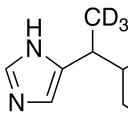A triterpene saponin from Tribulus terrestris attenuates apoptosis in cardiocyte via activating PKC signalling transduction pathway.
Palabras clave
Abstracto
The present study was conducted to examine the role of hecogenin-3-O-beta-D-glucopyranosyl(1-->4)-beta-D-galactopyranoside (1), which is a triterpene saponin of Tribulus terrestris in cardiocytes during chemical hypoxia-ischaemia in vitro. Neonatal rat ventricular myocytes were isolated by collagenase digestion and treated with NaCN for 12 h. Cell apoptosis was defined by terminal deoxynucleotidyl transferase-mediated dUTP nick end labelling (TUNEL) and flow cytometry. [Ca(2+)] was measured by confocal microscopy. There was a marked increase in the expression of the anti-apoptotic protein, Bcl-2, by NaCN. This change was increased by the saponin 1. PKCepsilon protein contents were increased in the cardiocyte membrane fraction in response to NaCN. PKCepsilon activation was augmented by the saponin 1. Inhibition of PKCepsilon with inhibitory peptide prevented Bcl-2 expression. Moreover, the saponin attenuated the apoptosis in cardiocyte in response to NaCN. It is therefore suggested that the saponin 1 may play a role in cardiocyte survival via PKCepsilon and Bcl-2.



